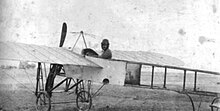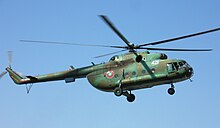Bulgarian Air Force
On 20 April 1906 "Vazduhoplavatelno Otdelenie" (roughly translated as Aviation Squad, literally Airsailing Section) was created to operate observation balloons for the Army, initially as a part of Railway Battalion.
[6] Intelligence about the Turkish army strength and dispositions in the Edirne was required, and on 16 October 1912, two aviators performed a reconnaissance flight over the city in an Albatros F.2 biplane, also dropping two bombs.
Foreign volunteers began flying operational sorties alongside Bulgarian pilots and carried out reconnaissance, leaflet-dropping and bombing missions.
Although inflicting little physical damage, the bombs had a devastating effect on the defending Turkish garrison's morale and played a crucial part in the fall of the city, which was until then considered nearly impregnable.
[5] In addition to the Albatros F.2, Bulgaria flew Blériot XI and XXI, Bristol Prier, Farman VII and Nieuport IV aircraft, as well as examples provided by Sommer and Voisin.
Throughout World War I Bulgarian military aviation experienced a steady increase in both numbers and quality of aircraft; however, they remained inferior to those flown by the Allies, especially the British and French.
Two Bulgarian Fokker E.IIIs were positioned south of Sofia to intercept the intruder, while a flight of three armed Albatros C.III two-seat trainers covered the center of the city as backup.
The bomber successfully dropped its bombs over Sofia while escaping anti-aircraft fire but, while departing, was attacked by the Bulgarian Fokkers, one piloted by Marko Parvanov, which brought the Farman down with a dead engine.
That airship flew a series of remarkable missions, such as an attempted resupply of the garrison in the colony German East Africa and the bombing of Naples and Port Said.
[citation needed] In accordance with the treaty during 1920 no less than 70 airplanes, 110 aircraft engines, 3 air balloons, 76 machine guns, a number of photographic cameras and other aviation equipment were destroyed at the military airfield of Bozhurishte.
Due to the devotion of the Air Troops personnel and the help of the population of the surrounding villages, several aircraft were hidden, thus evading Allied inspection following destruction.
During the same year the Bulgarian airplane construction specialist Atanas Grigorov (who obtained his qualification at the "Albatroswerke – Berlin") assembled a Friedrichshafen FF.33e seaplane from spares, which he called the "Grigorov-1".
The Bulgarian government invited a group of German aircraft engineers, headed by the constructor Herr Hermann Winter to help establish an aviation factory.
Named The State's Aeroconstruction Atelliér or Darzhavna Aeroplanna Rabotilnitsa (DAR) the factory was initially managed by the first Bulgarian pilot to achieve an aerial victory – Mr. Marko Parvanov.
[citation needed] The 1927 structure of the Directorate was the following: In 1928 the Ministry of War started the ambitious 10-year program for development of the military aviation (still banned by the peace treaty).
In 1933 the Bulgarian Council of Ministers approved the following wartime order of battle of the aviation: In 1934 the Aviation Regiment was renamed His Majesty's Air Troops, comprising a headquarters, with two army orlyaks (based at Bozhurishte and Plovdiv airfields), a training orlyak (in Plovdiv), a maritime yato (at NAS Chaika, Varna) and additional operational support units.
In 1936 Bulgaria ordered 14 PZL P.24B fighters and 12 PZL.43 light bombers from Poland, which due to the Spanish Civil War could not be delivered by sea and were instead shipped delayed by rail.
The reestablished air force was satisfied with the performance of new planes and in 1938, a second order was placed for 42 PZL.43A light bombers and 12 PZL P.24F fighters, which differed from the earlier versions in having more powerful engines, stronger armament and other improvements.
However, these plans were thwarted by the outbreak of World War II and the factory produced mainly training planes, including the most-produced Bulgarian aircraft, the Laz-7.
To help its new ally the 12th Army of the Wehrmacht offered support with its aircraft and air defence assets and provided 8 Freya-type radars dispersed throughout the country.
[citation needed] The first air strike against Bulgarian targets was carried out by 4 Yugoslav Dornier Do 17 Kb-1 on 6 April 1941 on the city of Kyustendil and its railway station killing 47 and injuring 95, mostly civilians.
[citation needed] As a part of the joint armed forces' effort on 26 June 1941 6 Avia B.71 and 9 Dornier Do 17M bombers were transferred to the Badem Chiflik airfield near Kavala (in Greece).
[citation needed] On 22 June 1941, Germany invaded the Soviet Union, but Bulgaria refused to take part, although it did declare war with Great Britain and the United States of America in December 1941.
For the citizens of Sofia, the "Black" days were 14 and 24 November, 10 and 20 December 1943, and 10 January and 16, 24, 30 March and 17 April 1944 when large formations of B-17 and B-24 bombers ruined parts of the capital city including the central area.
On 1 August 1943, an enormous armada of about 700 American Consolidated B-24 Liberator bombers flew over several Balkan countries their way to bomb "the taproot of German might", the giant oil refineries at Ploiești, Romania.
By 1954, these types were being withdrawn from service, as the Korean War marked the beginning of the jet fighter era and in 1955 a new wave of deliveries began, starting with the Mikoyan-Gurevich MiG-15.
[25] Since the early 2000s, Bulgaria has been actively trying to restructure its armed forces as a whole and a lot of attention has been placed on keeping the aging Soviet-era aircraft operational.
[27] The main competitors were expected to be the Eurofighter Typhoon, Dassault Rafale, Saab JAS 39 Gripen, Mikoyan MiG-29, MiG-35, CAC/PAC JF-17 Thunder, Lockheed Martin F-16, and McDonnell Douglas F/A-18 Hornet.
The deal would eventually bring the number of active service MiG-29 aircraft from 9 to 14, as Bulgaria also announced it was looking to overhaul the fleet and buy eight new or second-hand fighter jets during the coming year.
On 6 October 2020, the Bulgarian Ministry of Defence signed an order with Ukrainian state company "Ukrinmash" for the repair and refurbishment of one Antonov An-30, designed for aerial cartography, for лв. 6,200,000.




















